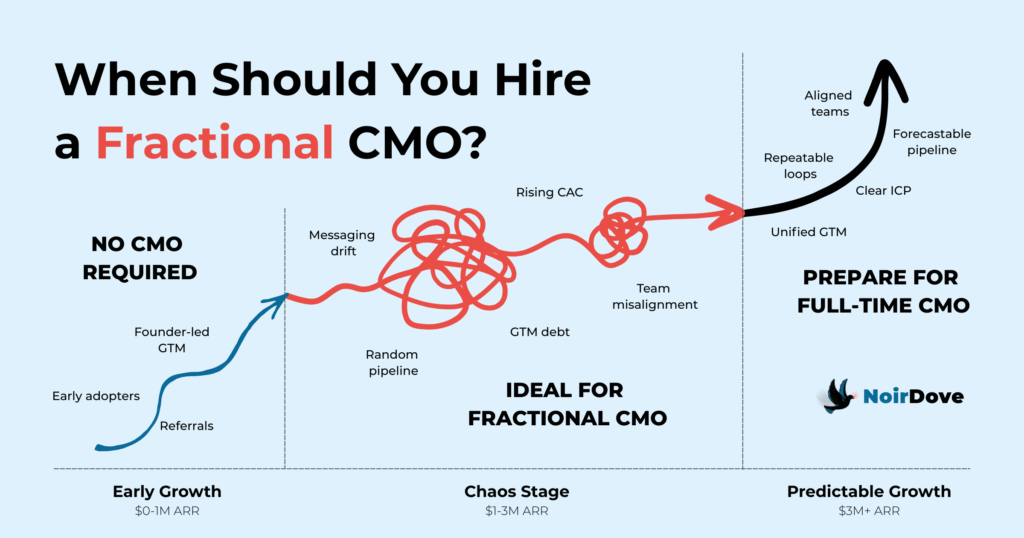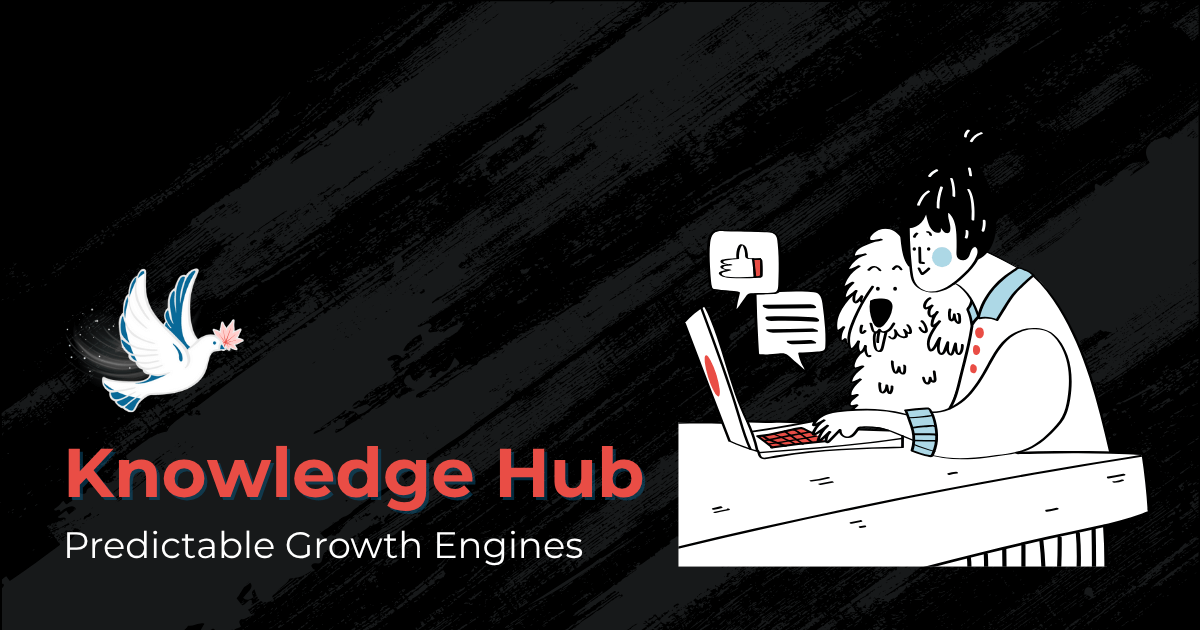Fractional CMO vs Full-Time CMO

The founders scaling from $1M to $10M ARR reach this inflection point, where growth becomes harder, not easier. The team is bigger, the spend is higher, but the output feels inconsistent. Marketing, sales, and product are moving, but not in rhythm. This is when most founders realize they need senior GTM leadership.
A choice between two paths lies ahead. Hire a fractional CMO now. Or hire a full-time CMO later.
Both are valuable roles, but they fit very different stages of your startup.
1. Founder Pain at the $1–10M Stage
Founders at this stage feel the weight of GTM complexity. Growth no longer responds to effort in a linear way. Problems are now about managing the system, not about doing the work.
Common frustrations include:
- You are still the one shaping the messaging and campaigns.
- The pipeline is unstable and hard to predict.
- CAC continues to climb upwards, while the channels don’t feel consistent at all.
- Marketing and sales do not agree on the quality of leads.
- Your team works hard, but the results feel scattered.
- Agencies produce deliverables, not outcomes.
- There is no one driving strategy.
- You don’t know what to focus on anymore.
- You feel stretched thin between execution and leadership.
- Growth feels random, not repeatable.
These are not marketing problems. These are leadership and system problems.
2. What is a Fractional CMO
A fractional CMO is a part-time senior marketing leader who owns your whole GTM strategy. They guide your team, align your narrative, and build the systems you need for predictable growth.
They offer executive-level clarity without the cost and risk of a full-time CMO.
3. What is a Full-Time CMO?
Full-time CMO: Long-term executive to lead brand, marketing, growth, and GTM strategy. Best fit for companies with mature teams, a stable revenue engine, and long-term scaling needs.
Full-time CMOs are ideal once you cross $10M ARR.
4. Comparison: Fractional CMO vs Full-Time CMO
Below is a straightforward, simplified comparison for founders, not HR teams.
| Category | Fractional CMO | Full-Time CMO |
|---|---|---|
| Stage Fit | $1–10M ARR | $10M+ ARR |
| Cost | Low, flexible monthly retainer | High salary + bonus + equity |
| Time Commitment | Part-time, strategic | Full-time, deep involvement |
| Primary Role | Build GTM foundation and systems | Scale and expand existing GTM |
| Speed of Impact | Immediate strategic clarity | Slower, needs team and budget |
| Team Leadership | Leads small or junior teams | Leads large multi-level teams |
| Focus Areas | Positioning, ICP, strategy, pipeline | Brand leadership, expansion, enterprise GTM |
| Execution Support | Hands-on direction with team | Manages managers, not tasks |
| Best For | Companies fixing GTM chaos | Companies scaling across regions |
| Risk Level | Low commitment, easy to adjust | High commitment and expensive if wrong |
| Expected Outcomes | Predictable pipeline, clear narrative, lower CAC | Large-scale brand visibility, long-term growth |
| Founder Involvement | Reduces founder dependency quickly | Founders still involved initially |
| Hiring Speed | Fast start | Long hiring cycle |
This table helps founders immediately see which model fits their stage.
5. The Ten Advantages of a Fractional CMO
1. Speedier impact with immediate strategic leadership
Full-time CMOs take months to hire. Fractional CMOs step in quickly and begin stabilizing your GTM from week one. This matters when pipeline is unstable.
2. Senior expertise at a fraction of the cost
You get the same leadership that a $300K executive can provide, just without the financial weight on the company. This makes it a safe option while the GTM engine is still forming.
3. Sharp positioning and clarity in ICP
Fractional CMOs specialize in the diagnosis of unclear messaging and weak positioning. Well, they define your story so that the market understands exactly why you exist.
4. Channel strategy that actually converts
Instead of trying everything, they find the channels that really work for your business and eliminate wasteful spend.
5. Better alignment between sales and marketing
They create one narrative, one ICP, and one pipeline model. This removes friction and increases win rates.
6. Leadership for junior marketing teams
Most companies with $1–10M have junior marketers that need direction. Fractional CMOs bring structure, clarity, and confidence to the team.
7. Better insights into why growth has slowed.
Fractional CMOs rapidly identify funnel leaks, messaging problems, misalignment, and channel waste, so you can make quicker, wiser decisions.
8. A GTM operating rhythm that drives accountability
They set up dashboards, meetings, scorecards, and repeatable systems that make growth steady instead of sporadic.
9. Scalability without long-term risk
You can ramp up or scale down engagement depending on the stage of the company. This flexibility is very important in case of market shifts.
10. Preparations for your future full-time CMO
Fractional CMOs prepare the company for a full-time CMO by developing team structure, GTM systems, and operational maturity.
6. When to Choose a Full-Time CMO
A full-time CMO is ideal when your GTM engine is already mature and you need a long-term leader to scale brand, team, and revenue.
Choose a full-time CMO when:
- Your company is growing past $10M ARR
- You have a marketing team that consists of more than ten people.
- You need enterprise-level brand building.
- You’re scaling across multiple countries
- You want an executive actively shaping long-term planning.
7. When to Choose a Fractional CMO
A Fractional CMO is ideal for your company when it is in GTM chaos and requires leadership to create predictability.
Choose a fractional CMO when:
- Pipeline is inconsistent
- CAC is too high.
- Marketing and sales are not aligned.
- Messaging feels off or unclear
- You have a team but no leader.
- You need strategic clarity fast
- You want to create predictable growth before you hire full-time.

Frequently Asked Questions (FAQs)
1. How can I tell whether I need a fractional CMO instead of a full-time CMO?
Fractional CMOs are the right choice if your GTM engine is still in the process of forming and you want clarity, alignment, and stability. Full-time CMOs make sense only when systems are already mature and you need long-term leadership across a large organization.
2. Can a fractional CMO really lead my entire marketing team?
Yes, fractional CMOs own GTM strategy, manage junior marketers and agencies, and set up the processes your team needs. They act like a true executive but just part-time.
3. How long should a fractional CMO engagement last?
Most companies see strong results in 6 to 18 months. This is enough time to build systems, create alignment, and make the growth engine self-sustaining.
3. What if my company eventually needs a full-time CMO?
Many companies start with a fractional CMO and then move to a full-time leader. In many cases, the fractional CMO will help with recruiting, onboarding, and setting up the structure for a successful handoff.
4. Are fractional CMOs hands-on or just consultants?
Fractional CMOs are hands-on leaders: they solve problems, make decisions, guide execution, and build systems. They do more than advise; they operationalize.
5. What is the appropriate duration of the fractional CMO engagement?
Most founders start to see meaningful improvements within 6 to 18 months. This allows enough time to reset positioning, build systems, stabilize pipeline, and prepare for long-term scale.


